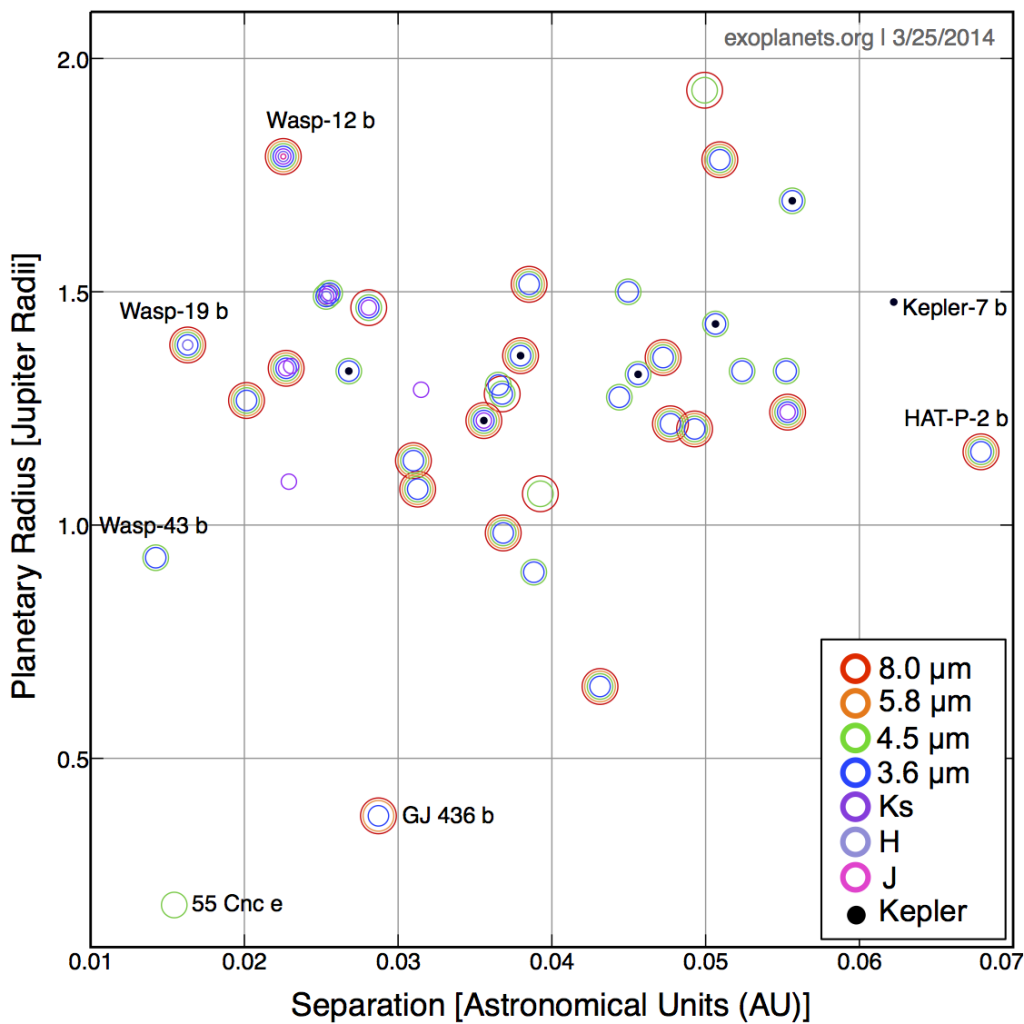
The exoplanets.org team at the National Harbor AA meeting — I mean American Astronomical Society meeting. From left: Sharon Wang (grad student, PSU), Eunkyu Han (now at Boston University), me, Katherina (Ying) Feng (now at UC Santa Cruz), and Ming Zhao (Research Associate, PSU).
Last time I detailed how the Catalog of Nearby Exoplanets evolved into the Exoplanet Orbit Database, thanks to the efforts of Onsi Fakhouri, Eunkyu Han, and Katherina Feng. A lot has happened since then.
Before starting his new job for a software company in San Francisco, Onsi did some work for the Kepler team producing the Kepler Planet Candidate Data Explorer, which built off of exoplanets.org but had lots of nifty new features and back-end improvements. I got an NSF grant, and the broader impact section was to expand and improve exoplanets.org and the EOD. This gave me some money to compensate Onsi for his work, but given the level he was now at professionally, we couldn’t actually afford him; it was still basically just weekend hobby work for him.
Onsi added in a feature where we incorporate all of the Kepler candidates from the NASA Exoplanet Archive into the EOD (optionally — there’s a toggle at the top of the page) so that you can plot them against the other exoplanets, or against themselves. He also added an “other” button so that users can see planets without good orbits (like most of the microlensing and imaged planets) on the same plots.
One issue with this is that there are not really any common planetary parameters that most RV planets have with, say, most imaged planets. So we had to create new “fuzzy” fields, MASS and SEP, which are “rough” masses and separations. When the masses and orbital semimajor axes are known, these fields take those values — otherwise they take minimum mass, projected separation, a mass based on the radius, or whatever the “best” value is for a given planet. This way, one can plot mass vs. separation for all of the heterogeneously discovered planets in the data explorer.
Eventually, Onsi had a second child, and that ate up enough of his remaining hobby time that he’s had to retire as exoplanets.org administrator. We’re looking for a replacement — if any readers know anyone who can do it, the job ad is here.
In the meantime, Eunkyu Han and Katherina Feng have been making big improvements. One is that they have gone back through the papers that report orbital and stellar parameters and incorporated asymmetric error bars, so that we can properly report uncertainties. They have linked every datum to a refereed paper on ADS (click any number and you’ll see!).
Ming Zhao has also included all measured secondary eclipse depths for all planets that have them, and these make for some really nifty plots.

Nifty plot showing planetary radius and orbital radius of exoplanets with secondary eclipse measurements. Each circle indicates the existence a different measurement in the refereed literature. This vector graphic plot (click for PDF) was made in Ming Zhao’s Web browser; he added annotations of some planets and the legend himself (the Exoplanet Data Explorer Plotter doesn’t do everything… yet!)
Writing all of this up constituted Eunkyu’s senior thesis, but fortunately for me Eunkyu was able to stay on at Penn State for a while as a post-baccalaureate researcher, during which time she worked with Sharon Wang to get it published. I’m happy to report that it was just published online at PASP, and you can find it on the arXiv here.
All the picky details of the new exoplanets.org are in there — go take a look!
So what are we working on now? Well, our new student, Jacob Brown, is busy taking care of the bug reports that come in to datamaster@exoplanets.org, and trying to keep up with the large planet discovery rate these days. We’re also working with the Exoplanet Archive to make sure that all RV-detected planets have their published radial velocities in a common format there — NExScI stopped ingesting these from the literature a while back, so we’ve teamed up with them and Jacob is doing that now.
We have added 118 new RV plots, including that for 24 Sex c: http://t.co/MfmtC83oin Check out those curves!
— exoplanets.org (@ExoplanetsOrg) August 24, 2014
We recently added over 100 new RV plots to the website — these serve both to indicate that we have properly interpreted the literature RVs and as a check on the parameters in the EOD (sometimes we have a mistake; sometimes the mistake is in the literature!)
We’re also looking to properly record upper limits and have the website handle them, and a few more things listed in the paper.
Remember, if you use exoplanets.org in your research, please include the acknowledgement we suggest on our front page in your work, and please cite Han et al. 2014! Thanks!


This is cool! I saw the paper on ArXiv this morning! This is a great website!